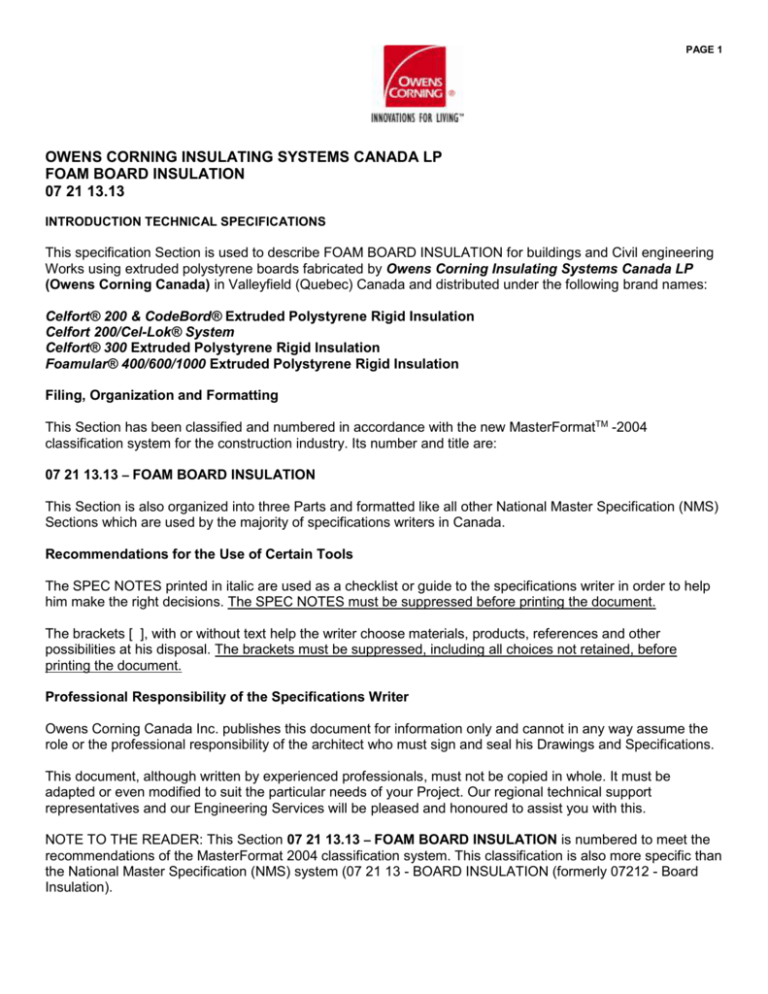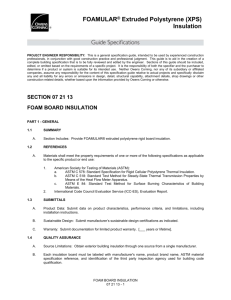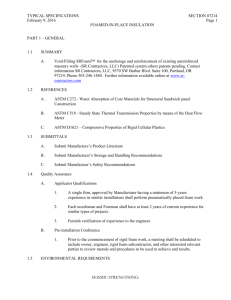
PAGE 1
OWENS CORNING INSULATING SYSTEMS CANADA LP
FOAM BOARD INSULATION
07 21 13.13
INTRODUCTION TECHNICAL SPECIFICATIONS
This specification Section is used to describe FOAM BOARD INSULATION for buildings and Civil engineering
Works using extruded polystyrene boards fabricated by Owens Corning Insulating Systems Canada LP
(Owens Corning Canada) in Valleyfield (Quebec) Canada and distributed under the following brand names:
Celfort® 200 & CodeBord® Extruded Polystyrene Rigid Insulation
Celfort 200/Cel-Lok® System
Celfort® 300 Extruded Polystyrene Rigid Insulation
Foamular® 400/600/1000 Extruded Polystyrene Rigid Insulation
Filing, Organization and Formatting
This Section has been classified and numbered in accordance with the new MasterFormatTM -2004
classification system for the construction industry. Its number and title are:
07 21 13.13 – FOAM BOARD INSULATION
This Section is also organized into three Parts and formatted like all other National Master Specification (NMS)
Sections which are used by the majority of specifications writers in Canada.
Recommendations for the Use of Certain Tools
The SPEC NOTES printed in italic are used as a checklist or guide to the specifications writer in order to help
him make the right decisions. The SPEC NOTES must be suppressed before printing the document.
The brackets [ ], with or without text help the writer choose materials, products, references and other
possibilities at his disposal. The brackets must be suppressed, including all choices not retained, before
printing the document.
Professional Responsibility of the Specifications Writer
Owens Corning Canada Inc. publishes this document for information only and cannot in any way assume the
role or the professional responsibility of the architect who must sign and seal his Drawings and Specifications.
This document, although written by experienced professionals, must not be copied in whole. It must be
adapted or even modified to suit the particular needs of your Project. Our regional technical support
representatives and our Engineering Services will be pleased and honoured to assist you with this.
NOTE TO THE READER: This Section 07 21 13.13 – FOAM BOARD INSULATION is numbered to meet the
recommendations of the MasterFormat 2004 classification system. This classification is also more specific than
the National Master Specification (NMS) system (07 21 13 - BOARD INSULATION (formerly 07212 - Board
Insulation).
PAGE 2
Part 1
General
1.1
SECTION INCLUDES
.1
Thermal insulation using extruded polystyrene board insulation at the following locations:
.1
Below grade, on interior face of foundation walls [and] [on the exterior face of foundation
walls not submitted to special loading].
.2
Above grade, on exterior face of concrete masonry unit [concrete] [gypsum board] cavity
wall back-ups with masonry [___] veneer.
.3
Inside buildings, on interior face of foundation walls.
.4
Under slabs on grade.
.5
Under slabs on grade of skating rinks [refrigerators-freezers].
.6
Garden [pedestrian] terraces, [parking areas] situated over heated spaces.
.7
[Landing strips], [railroads], [highways], [bridge abutments], [sidewalks], [retaining walls],
[landscaping], [___________] [Civil Engineering Works] [and] [large construction
projects].
.8
Permafrost protection Works.
.2
Accessories required to apply and maintain insulation in place.
1.2
RELATED SECTIONS
.1
.2
.3
.4
.5
.6
.7
.8
.9
.10
.11
.12
.13
1.3
Section 03 30 00 – Cast in Place Concrete
Section 04 05 00 – Masonry Procedures [: connectors][: gaskets or flashings]
Section 07 11 13 – Bituminous Damp-proofing
Section 07 12 00 – Liquid Applied Bituminous Rubber [Modified Bituminous Sheet]
Waterproofing
Section 07 26 00 – [Underslab] Vapour Retarder
Section 07 27 10 – Air Barriers
Section 09 21 16 – Gypsum Board
Section 31 23 00 – Excavation and Backfilling
Section 32 46 21 – Foundation and Underslab Drainage
Section 31 00 00 – Earthwork
Section 32 00 00 – Landscaping
Section 33 00 00 – Public Utilities
Section 34 00 00 – Roadway [Airport] [Railway] Work
REFERENCES
.1
Underwriters' Laboratories of Canada (ULC)
.1
CAN/ULC-S701, Standard for Thermal Insulation, Polystyrene, Boards and Pipe
Covering
.2
CAN/ULC-S102.2, Standard Method of Test for Surface Burning Characteristics of
Flooring, Floor Covering and Miscellaneous Materials and Assemblies
.3
CAN/ULC-S604, Type A Chimneys
.2
American Society for Testing and Materials International, (ASTM)
.1
ASTM C177, Standard Test Method for Steady-State Heat Flux Measurements and
Thermal Transmission Properties by Means of the Guarded-Hot-Plate Apparatus
.2
ASTM C203, Standard Test Method for Breaking Load and Flexural Properties of BlockType Thermal Insulation
PAGE 3
.3
ASTM C518, Standard Test Method for Steady-State Thermal Transmission Properties
by Means of the Heat Flow Meter Apparatus
Plastics Between -30°C and 30°C With a Vitreous Silica Dilatometer
.5
ASTM D1621, Standard Test Method for Compressive Properties of Rigid Cellular
Plastics
.6
ASTM D2126, Standard Test Method for Response of Rigid Cellular Plastics to Thermal
and Humid Aging
.7
ASTM D2842, Standard Test Method for Water Absorption of Rigid Cellular Plastics
.8
ASTM E96, Test Methods for Water Vapor Transmission of Materials
.3
Canadian Gas Association (CGAl)
.1
CAN/CSA-B149.1HB, Natural Gas and Propane Installation Code Handbook
.2
CAN/CSA-B149.2, Propane Storage and Handling Code
.4
Canadian General Standards Board (CGSB)
.1
CGSB 71-GP-24M, Adhesive, Flexible, for Bonding Cellular Polystyrene Insulation
.5
Health Canada/Workplace Hazardous Materials Information System (WHMIS)
.1
Visit www.owenscorning.ca for an current copy of the Material Safety Data Sheet
(MSDS).
.6
Canadian Construction Materials Centre (CCMC) Product Evaluation, published by the Institute
for Research in Construction (IRC) of the National Research Centre Canada (CNRC):
[.1
CELFORT 200: product listing number CCMC 11246-L.]
[.2
CODEBORD: product listing number CCMC 11246-L.]
[.3
CELFORT 200/CEL-LOK: product listing number CCMC 11246-L.]
[.4
CELFORT 300: CCMC product listing number 11247-L.]
1.4
SUBMITTALS
.1
Submit manufacturer's product data in accordance with Section [01 33 00 - Submittal
Procedures] [01 47 15 - Sustainable Requirements: Construction].
[.2
Submit proof of manufacturer's CCMC Listing and Listing number to [Engineer] [Consultant]].
.3
Submit environmental certificates issued by independent agencies and the evaluation of the
products' contribution towards obtaining LEEDTM Canada credits mentioned in article QUALITY
ASSURANCE.
.4
Submit WHMIS MSDS - Material Safety Data Sheets in accordance with Section [02 61 33 Hazardous Materials]. Indicate VOC content.
.5
Submit samples in accordance with Section [01 33 00 - Submittal Procedures] [01 47 15 Sustainable Requirements: Construction].
PAGE 4
.1
[.2
1.5
One [two] sample[s] of each type polystyrene board, 600 x 600 mm x indicated
thickness, including the following required information printed on one face:
.1
Reference standard product meets
.2
Board Type, name of manufacturer or brand name
.3
CCMC Product Listing Number
.4
The following cautionary statement: Combustible product. Protection or thermal
barrier is required in accordance with applicable building codes.
One [two] sample[s] of each type specified accessory and fastener.]
QUALITY ASSURANCE
.1
Identification: Each insulation board must be clearly labelled with the information listed in
manufacturer's applicable Product Data Sheet.
.2
Environmental certification by an independent agency:
.1
Submit the "GREENGUARD Standard for Low Emitting Products Certified" certificate
issued by the GREENGUARD Environmental Institute (GEI) certifying that the described
polystyrene foam board insulation meets low VOC emission requirements contained in
the tested product; web site : www.greenguard.org.
.2
Submit the certificate issued by the Scientific Certification Systems (SCS) certifying that
the described polystyrene foam board insulation meets the recycled materials content
requirements in the tested product; web site : www.scscertifed.com.
.3
The certificates shall include the following details: certificate number, and all restrictions
issued by the certification agency for the product[s], as applicable.
.3
Contribution of Owens Corning’s extruded polystyrene foam board insulations to the LEED
certification of the building Project:
.1
Categories and performance criteria to obtain credits, as established by the Canadian
Green Building Council Rating System LEED CANADA-NC Version 1.0.
.1
Energy and Atmosphere (EA): credit 1 for the optimization of new or existing
building energy performance.
.2
Materials and Resources (MR): credits 4.1 & 4.2 for post-industrial and postconsumer recycled materials content.
.3
Materials and Resources (MR): credits 5.1 & 5.2 for locally or regionally
produced materials.
1.6
DELIVERY, STORAGE AND HANDLING
.1
1.7
Deliver, store and handle polystyrene foam insulation boards in accordance with manufacturer's
printed instructions.
WASTE MANAGEMENT AND DISPOSAL
.1
Separate waste materials for [reuse] [and] [recycling] in accordance with Section [01 74 19 Construction/Demolition Waste Management and Disposal].
.2
Remove from site and dispose of packaging materials at appropriate recycling facilities.
.3
Collect and separate for disposal [paper] [plastic] [polystyrene] [corrugated cardboard]
packaging material [in appropriate on-site bins] for recycling in accordance with Waste
Management Plan.
PAGE 5
1.8
SITE ENVIRONMENTAL REQUIREMENTS
.1
Apply polystyrene foam board insulation only when ambient climatic conditions (risk of rain, high
humidity levels) and temperature of surfaces to be insulated are within acceptable limits to
prevent risk of condensation.
.2
Safety: Comply with requirements of Workplace Hazardous Materials Information System
(WHMIS) regarding use, handling, storage, and disposal of insulation materials.
Part 2
Products
2.1
INSULATION
.1
PINK extruded polystyrene rigid board insulation to CAN/ULC-S701, Type 3:
.1
RSI 0.87 / 25 mm, 140 kPa compressive strength (20 psi)
.2
Water vapour permeance (max.): 45 ng / Pa.s.m2
.3
Dimensions: 610 mm [1220] mm x 2438 [2743] mm x [25] [38] [51][64][76][102] mm
[thickness as indicated], ship lapped [square] edges
.4
Selected product: CELFORT 200 [CODEBORD] manufactured by Owens Corning
Canada
.2
PINK extruded polystyrene rigid board insulation to CAN/ULC-S701, Type 4:
.1
RSI 0.87 / 25 mm, 210 kPa compressive strength (30 psi)
.2
Water vapour permeance (max.): 45 ng / Pa.s.m2
.3
Dimensions: 610 mm x 2438 mm x [25] [38] [51][64][76][89][102] mm [thickness as
indicated], ship lapped [square] edges
.4
Selected product: CELFORT 300 manufactured by Owens Corning Canada
PINK extruded polystyrene rigid board insulation, to CAN/ULC-S701, Type 4:
.1
RSI 0.87 / 25 mm, [275] [415] [690] kPa compressive strength ([40][60][100] psi)
.2
Dimensions: 610 mm x 2438 mm x [25] [38] [51][76] ][102] mm [thickness as indicated],
square edges
.3
Selected product: FOAMULAR [400] [600] [1000] manufactured by Owens Corning
Canada
.3
.4
PINK extruded polystyrene scored rigid board insulation to CAN/ULC-S701, Type 3:
.1
RSI 0.87 / 25 mm, 140 kPa compressive strength (20 psi)
.2
Water vapour permeance (max.): 45 ng / Pa.s.m2
.3
Dimensions: 610 mm 2438 mm x [25] [38] [51][64][76][102] mm [thickness as indicated],
ship lapped edges
.4
0.46 mm [28 Gauge] metal furring channels: 9.5 mm x 38 mm x 2413 mm;
.5
Selected product: Celfort 200/CEL-LOK System manufactured by Owens Corning
Canada
.5
One component polyurethane foam sealant to CAN/ULC-S710.1 (material) and S710.2
(installation); compatible with extruded polystyrene rigid insulation board.
2.2
.1
ADHESIVES
Adhesive for polystyrene, to CGSB 71-GP-24M
.1
Type: [___]
.2
Class: [___]
PAGE 6
.3
.4
2.3
.1
VOC emission: [___]
Selected product: [____________].
FASTENERS
Screws: self-tapping type for steel [masonry anchors for concrete] with minimum 25 mm
diameter plastic or metal washers, zinc coated by electrolytic process, #8-18, of sufficient length
to penetrate substrate minimum 25 mm. [1 in.]
.2
Nails: .spiral nails with minimum 25 mm diameter plastic or metal washers, of sufficient length to
penetrate substrate minimum 25 mm. [1 in.]
.3
CEL-LOK fastening system; metal furring, 0.46 mm thick (28 Gauge) x 38 mm (1.5 in.) wide x
9.5 mm, deep(3/8 in.) x 2413 mm long (95 in.) with a minimum of four self-tapping screws per
length of channel; self-tapping screws of sufficient length to penetrate substrate minimum 25
mm. [1 in.]. Metal furrings spaced a maximum of 600 mm. [24 in.] o.c.
Part 3
Execution
3.1
WORKMANSHIP - GENERAL
.1
3.2
Compliance: comply with manufacturer's requirements, recommendations and written
specifications, including product Technical Bulletins, Product Catalogue installation instructions,
product package installation instructions, and Product Data Sheets.
EXAMINATION
.1
Examine substrates and do not proceed with installation until defects have been corrected.
.1
Ensure substrates are solid, [fill materials are well compacted and drained], free of
protrusions and true to plane (i.e. free of undulations), free of dust and debris [of snow,
ice, frost] and ready to receive foam insulation boards.
PAGE 7
3.3
WORKMANSHIP
.1
Coordinate adjacent, underlying and penetrating work which must be completed prior to
insulation work or those that will be installed after insulation work.
.2
Install insulation to maintain continuity of thermal protection to building elements and spaces.
.3
Fit insulation tight around electrical boxes, plumbing and heating pipes and ducts, around
exterior doors and windows and other protrusions.
Keep insulation minimum [75] [___] mm from heat-emitting devices such as recessed light
fixtures, and minimum [50] [___] mm from [sidewalls of CAN4-S604 type A chimneys] [and]
[CAN/CGA-B149.1 and CAN/CGA-B149.2 [type B] [and] [L] vents].
.4
3.4
.5
Cut and trim insulation neatly to fit spaces. Butt joints tightly, offset vertical joints. Use only foam
insulation boards free from chipped or broken edges. Use largest possible dimensions to reduce
number of joints.
.6
Use boards with ship lapped edges where joint overlap is required in single layer applications.
.7
Offset both vertical and horizontal joints in multiple layer applications.
.8
Fastening:
.1
Adhesive:
.1
Apply Type [___] adhesive to [insulation board] [substrate] at rate of [___]L/m2by
[notched trowel] [___] in accordance with adhesive manufacturer's
recommendations.
.2
Leave insulation board joints unbonded over line of expansion and control joints.
Bond a continuous elastomeric membrane over expansion and control joints
using compatible adhesive and primer before application of insulation.
.2
Mechanical fastening:
.1
Fasten insulation boards using mechanical fasteners appropriate to substrate, at
minimum rate of one fastener per 0.19 m2 (2 sq.ft.).
.9
Temporarily protect installed insulation boards from inclement weather, excessive sunlight and
other physical damages.
PERIMETER FOUNDATION INSULATION
.1
Interior application: extend boards [[___] mm vertically below bottom of finish floor slab]
[as indicated], installed on inside face of perimeter foundation walls.
.2
Exterior application: extend boards [[___] mm minimum below finish grade] [as indicated]
[to top of footing]. Install on exterior face of perimeter foundation wall with adhesive
[fasteners].
.3
Under slab application: extend boards [[___] mm in from perimeter foundation wall] [as
indicated]. Lay boards on level compacted fill.
[.4
Perimeter heating duct application: compact walls of heating duct trench to form solid
backing. Attach insulation boards to perimeter foundation wall extending from underside
PAGE 8
of finish floor to [100] [___] mm below bottom of heating duct. Lay insulation boards in
bottom of heating duct trench, extend to [[150] [___] mm beyond heating duct] [[600]
[___] mm minimum from inside face of perimeter foundation wall]. Secure insulation in
place to prevent displacement.]
3.5
INSULATING WORK PROJECTS SUBJECTED TO SPECIAL LOADING
.1
Install high density insulation boards having an appropriate minimum [275] [415] [690] kPa
compressive strength where indicated on the Drawings.
.2
Ensure compatibility between insulation boards and adhesives employed to adhere boards to fill
or to themselves (multiple layer application).
.3
Install insulation boards and butt joints tightly; offset all transverse joints, placing board long
dimension parallel to median line of surface to be covered; start installation from centre and
work out towards edges of surface as dimensioned on the Drawings.
[.4
Provide transition zone at each extremity of thermally insulated road sections to ensure a
gradual transition of the fill's thermal properties. Reduce insulation thickness by 25 mm [1 in.] for
each 4.9 m [16 ft.] of road length.]
.5
Retain insulation boards using backfill material or wood [steel] pegs in sufficient number to avoid
displacement due to wind or flotation where water is present.
[.6
Where required, adhere insulation boards using an adhesive to temporarily maintain boards in
place, as required by manufacturer.]
[.7
Wrap concrete or masonry work below or partially below grade (i.e. pilon foundations) to
minimize frost adherence and reduce frost heave that may cause damaging distortions to the
steel [concrete][wood] structure.]
.8
Prohibit vehicular and heavy equipment traffic directly on insulation to avoid damage.
.9
Do not enclose insulation until it has been inspected and approved by Engineer [Architect].
3.6
CLEANING
.1
Upon completion of the installation, remove surplus materials, rubbish, tools and equipment
barriers.
PAGE 9
OWENS CORNING INSULATING SYSTEMS CANADA LP
Head Office and Sales
3450 McNicoll Avenue
Scarborough, Ontario
M1V 1Z5
Tel: 1 800 504-8294
Fax: 1 800 504-9698
email: salvatore.ciarlo@owenscorning.ca
MasterFormat is a trademark of the Construction Specifications Institute, Inc. LEED is a trademark of U.S. Green Building Council. GREENGUARD
Indoor Air Quality Certified is Reg. U.S. Pat & TM Office. The colour PINK is a registered trademark of Owens Corning. © 2006-2007 Owens Corning.
All Rights Reserved.
Publication # 200023
Printed in Canada August 2007








